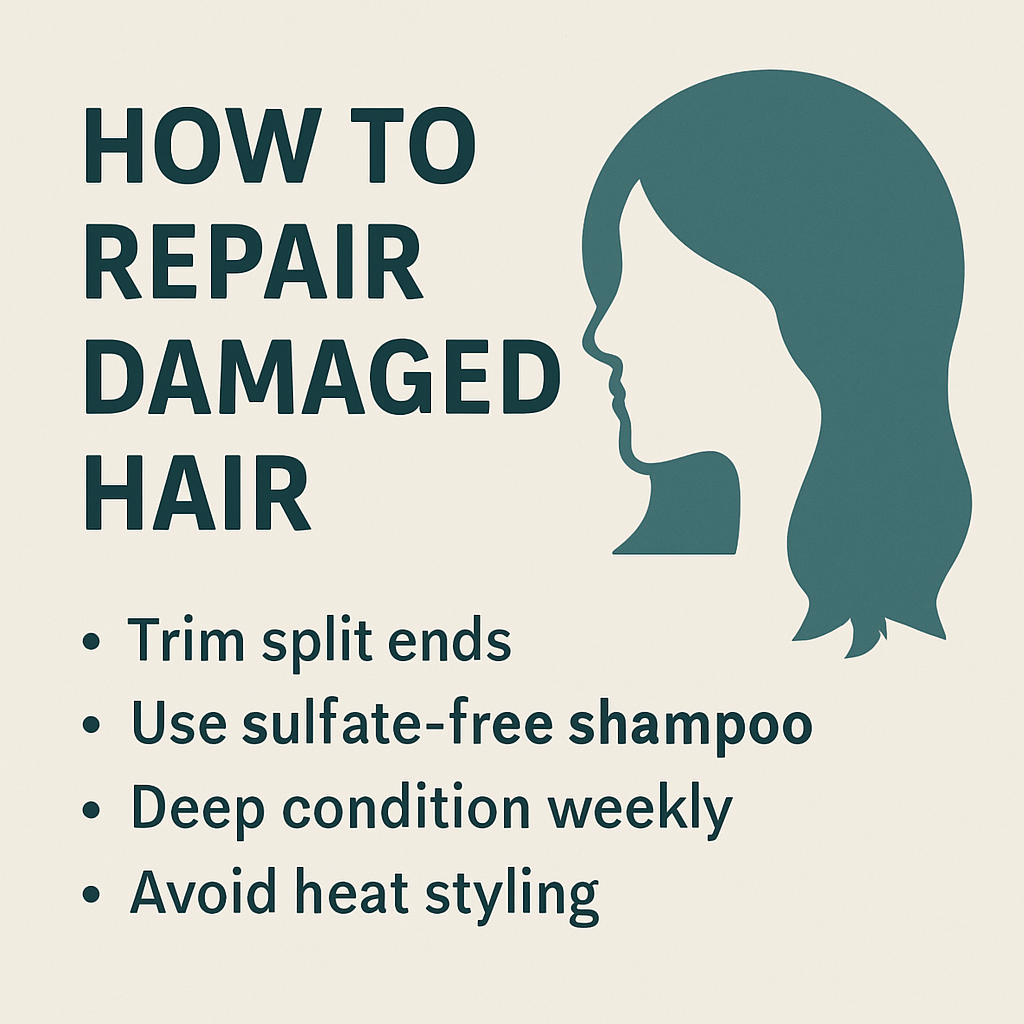How to Repair Damaged Hair: Expert Tips and Treatment Guide
Damaged hair is a common problem caused by heat styling, coloring, environmental stress, and poor care routines. Whether you’re dealing with breakage, split ends, or dryness, it’s possible to revive your hair with the right strategy. This expert guide explains how to repair damaged hair with science-backed treatments and effective routines.
Signs of Damaged Hair
Recognizing the symptoms of hair damage is the first step toward restoration:
- Split Ends: Hair that frays or splits at the tips.
- Dryness: Hair lacks moisture, feels rough.
- Breakage: Hair snaps easily during brushing or styling.
- Lack of Shine: Damaged cuticles cause a dull appearance.
- Frizz: Disorganized strands that resist smoothing.
- Tangles: Frequent knots that indicate cuticle damage.
Causes of Hair Damage
Understanding the root causes helps you prevent future harm:
- Heat Styling: Frequent use of flat irons, curling wands, and blow dryers without heat protection.
- Chemical Treatments: Coloring, bleaching, perms, and relaxers weaken the hair structure.
- UV Exposure: Sunlight breaks down protein bonds in hair.
- Poor Hair Products: Sulfates, alcohols, and harsh cleansers strip natural oils.
- Tight Hairstyles: Braids, ponytails, or buns that tug and stress the hair shaft.
Step-by-Step Repair Strategy
1. Trim the Damage
Start with a professional trim to remove split ends. Regular trims every 6–8 weeks prevent damage from spreading.
2. Switch to Sulfate-Free Shampoo
Choose gentle, moisturizing shampoos labeled “sulfate-free” to avoid stripping natural oils. Look for ingredients like aloe vera, coconut oil, and shea butter.
3. Use Deep Conditioning Treatments
Weekly deep conditioners restore moisture and elasticity. Opt for products with hydrolyzed proteins, argan oil, or ceramides.
Recommended Treatments:
- Hair masks with keratin or collagen
- DIY mask with honey, avocado, and olive oil
4. Incorporate Protein Treatments
Protein treatments strengthen the hair shaft and rebuild broken bonds. Use once every 2–4 weeks depending on your hair’s condition.
Tip: Alternate protein and moisture treatments to maintain balance.
5. Avoid Heat Styling
Minimize heat exposure. If you must use heat, apply a thermal protectant and use the lowest setting.
Home Remedies to Repair Hair
These natural treatments are effective and affordable:
- Coconut Oil Overnight Mask: Nourishes and repairs protein loss.
- Egg Yolk + Olive Oil: Rich in protein and essential fatty acids.
- Aloe Vera Gel: Soothes the scalp and moisturizes strands.
- Banana + Honey Mask: Smooths and softens dry hair.
Lifestyle Tips for Hair Repair
- Sleep on a silk pillowcase to reduce friction and breakage.
- Use a wide-tooth comb to detangle wet hair.
- Avoid over-washing. Shampooing 2–3 times a week is ideal.
- Eat a balanced diet with biotin, omega-3s, and vitamin E.
Salon Treatments That Work
Professional treatments offer intensive repair:
- Keratin Treatment: Smooths and strengthens hair using keratin protein.
- Olaplex Bond Repair: Rebuilds internal hair bonds broken by chemicals or heat.
- Hair Botox: Deep hydration that restores shine and elasticity.
- Scalp Detox: Removes buildup and stimulates hair growth.
Maintenance for Repaired Hair
After restoring your hair, maintenance is key:
- Regular trims
- Weekly deep conditioning
- UV protection sprays
- Avoid aggressive brushing
Final Thoughts
Repairing damaged hair is absolutely possible with the right mix of treatments, patience, and preventative care. Choose the right products, nourish from within, and treat your hair with the same care you give your skin.
Internal Links:
- How to Get Rid of Split Ends Without Cutting — anchor: get rid of split ends
- The Truth About Keratin Hair Treatment — anchor: keratin hair treatment
- Best Natural Oils for Hair Growth and Repair — anchor: natural oils for hair repair

